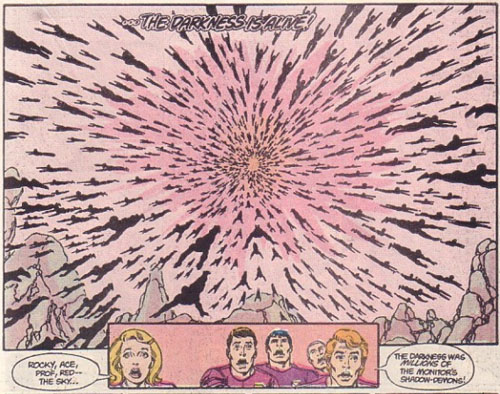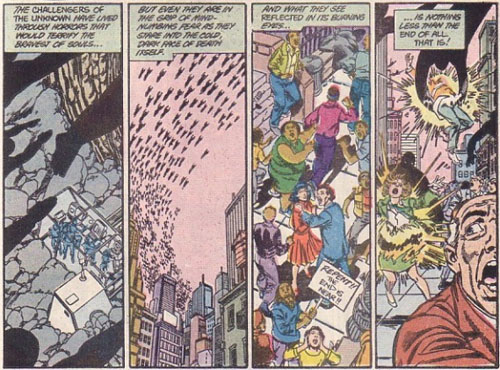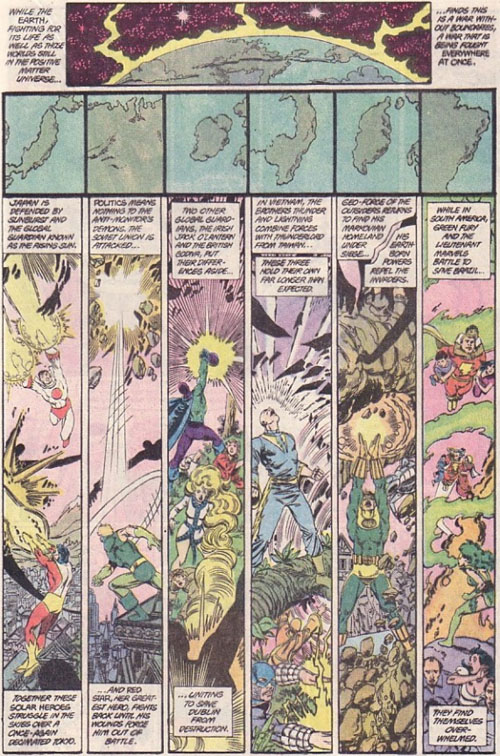I referred to the “battle around the world” sequence in Crisis On Infinite Earths last week and then a couple of people who hadn’t read it emailed me and asked me why it was so brilliant. Consider this the Cliffs Notes introduction, then.
So, a bit of recap. Previously, the super-baddie Anti-Monitor tried to blow up all the various alternate universes in the DC Universe, and in fact managed to kill all of them except Earth-1 (the Justice League’s world), Earth-2 (the JSA’s world), Earth-4 (the world with the Charlton heroes like Blue Beetle, Question and Captain Atom), Earth-X (the world with the Quality heroes – Uncle Sam, the Ray, the Human Bomb, et cetera) and Earth-S (the Fawcett heroes like Captain Marvel and the rest of the Shazam! family). The heroes stopped him from doing this multiple times and then managed to fuse all of the Earths into one uniform Earth. The Anti-Monitor was not pleased and as a final gambit pulled the new Earth into his Anti-Matter Universe entirely, reasoning (correctly) that if he destroyed the Earth and its heroes, the rest of the matter universe would probably be much easier pickings. After a great “I am the villain and you are going to die” speech, the Anti-Monitor cloaks the entire planet in shadow.
(Anybody complaining about how the Earth would instantly freeze without the sun or how matter and anti-matter would make each other go foom instantly: comics. Shut up.)
Anyhow. A few scenes with the entire world cloaked in shadow, and then:

This is pretty good leadup, right here. There’s nothing particularly outstanding yet – Wolfman’s prose is exactly the right shade of purple and Perez doesn’t have much to do except draw mostly-black and gradually reveal a couple of Challengers of the Unknown – but if you’re going to start a drumroll, this is how you do it. Half a page of tension, and then…

Ba-BAM. That’s a great little twist right there: the shadow wasn’t hiding the eventual threat to Earth, the shadow was the threat. It’s a clever inversion of expectations and it works spectacularly well – not least because the Challengers of the Unknown all look like they’re about to piss their pants. (Which is a great use for the Challengers, really, in this comic; they’re just normal dudes in tights when you get right down to it, but they’re normal duded who have seen everything, so having them in peepants mode underscores the gravity of the situation.)
And for those wondering, in the original comic this was a page-turn reveal. Not enough comic writers/artists these days seem to appreciate the concept of the page-turn reveal; I’m not sure if that’s because of modern advertisement demands making pacing more difficult or the gradual shift in storytelling to longer stories, but when I was nine it made a difference to turn the page and see the shadow demons exploding and the Challengers going “ohhhhhhh shit.”

This is still the same page, and in the remaining half a page Wolfman doesn’t just have the Challengers say “this is so bad guys they will kill everybody” to make the shadow demons scary. He sums it up in four panels without needing any expository dialogue:
1.) The shadow demons can fly
2.) There are buttloads of them and they are everywhere
3.) They are scary
4.) And they disintegrate people
The prose remains admirably purple, but purple in just the right ways – it has that Tolkienesque quality of “you couldn’t say this out loud and sound anything but cheesy, possibly even if you have a British accent, but in your head it is the greatest shit ever.” And it’s not explicitly descriptive of the situation, but rather talks about mood; Wolfman trusts Perez to make it scary and explain what’s going on.
In one page, with no villainous speech or exposition, Wolfman and Perez have put together the threat: it’s the evil-as-tidal-wave motif. One page. That’s the beat; now it’s time for the response.

What I like about the response page is that it doesn’t have Superman and Wonder Woman and Batman all standing together with some defiant pose saying “we’re the Trinity motherfuckers.” DC has gotten deeply into the comic-book equivalent of starfucking over the past decade: everything that’s supposed to be inspirational has to involve a forthright pose with hands on hips. And possibly a catchphrase.
This isn’t that. This is the superheroes getting down to business. And it’s very much a street-level sort of business: the biggest “name” on this page is probably Cyborg, the undisputed king of the B-list. (I mean, check out panel two: Blue Devil, Judomaster, Black Condor and Air-Wave? That is some seriously low-rent superheroing happening there.) None of them says a word because this is a situation that’s too busy for speeches.
I also like Perez’ use of perspective here. He alternates “awesome perspective” in panels 1, 3 and 5 (where the POV has to be from someone flying or, well, swimming deep underwater) with a very man-on-the-street perspective in panels 2, 4 and 6. It grounds the entire thing, never letting the reader forget that the heroes are fighting off the shadow demons amidst hordes of screaming people and that this is an end-of-the-world sort of fight.
Wolfman’s prose remains florid but effective; there is no room for irony here.

Finally: I fucking adore the design on this page. People have over time mistakenly concluded that George Perez’s great strength as an artist is to draw six billion dudes fighting six billion other dudes all at once (IE, the splash pages in Legion of Three Worlds) and although he’s good at that, that’s never been his great strength; his great strength has always been storytelling a good comics fight, allowing action to become complex without ever letting his depiction of it become too complex for the reader to easily enjoy. I think this page is the apex of that, because there are so many ways that “show superheroes all over the world fighting the shadow demons” could have been ugly, but instead you get this incredibly clean page. I’ve seen more than one artist swipe the idea since then, because the match-atlas-to-superheroes concept is intuitive and clever.
I’m also very impressed with how well he uses tall, skinny panels, which are difficult to incorporate into a narrative because we don’t generally think of super-action taking place on a vertical level. (Short, wide panels, on the other hand, you see all the time: if Superhero A shoots a blast beam from his hand at Villain B, that works just fine in a short wide panel.) I think if Perez had opted for a page of short wide panels – IE, this page, but going from up to down rather than right to left – it wouldn’t have worked nearly so well, because the world is round, and we think of travel around the world, not up and down it.
So, in summation, this is one of the best climatic battle sequences ever. What it especially reminds me of is how, at the end of Return of the Jedi, Richard Marquand cuts back and forth effortlessly between the giant space battle and the Endor forest battle and Luke versus Vader/the Emperor, letting the dramatic beats from each continually amp up the drama. Crisis #12 is like that, except that it does this in layers: all the various elements/crosscuts in the battle-across-the-world sequence then start cutting into the magicians’ chant sequence and the big-guns’-fight-against-the-Anti-Monitor sequence, both of these latter sequences also having their own crosscuts. It’s one of the great examples of pacing in superhero comics, and it’s never been equalled since.


Related Articles
22 users responded in this post
COIE is probably what cemented my lifelong love of comics. I was reading it as a 7-8 year old kid, as it came out.
Neat.
So, who’s the hero in speedoes riding the giraffe? Because a giraffe-riding superhero is a bit of DC’s past that I am frankly unfamiliar with.
@Zeno:
B’wana Beast. Morrison used him in his Animal Man run and he’s popped up in episodes of Justice League Unlimited (the one where Circe turns Wonder Woman into a pig) and Batman: the Brave & the Bold where he helps Bats fight a giant robot thingy. I think it was Black Manta’s…
Mr. Speedo Giraffe would be B’wana Beast, a character so popular that he’s shown up in the funny books at least five times since his first appearance in the late 60s. He also popped up in a couple episodes of the Justice League Unlimited cartoon.
He’s even got a wikipedia entry you can check out: http://en.wikipedia.org/wiki/Bwana_beast
I would suggest that MGK use B’wana Beast as one of his upcoming Thursday Who’s Who posts, but I’m not sure if he even got a mention in the Who’s Who book.
Didn’t James Robinson turn B’wana Beast into Prometheus’s throw rug or something?
No, that was Freedom Beast, the (black) successor to B’wana Beast invented by Morrison. I suspect now there will be a brand new B’wana Beast who will be white JUST LIKE IT WAS IN THE 1960s.
Speaking of James Robinson, note that Congo Bill shows up in the Africa panel as well (next to the giraffe).
Part of me love love loves these ginormous world-threatening fights…and another part of me always instinctively looks for the hero (or villain) who’s so far out of his weight class that it might as well be *me* out there in tights. This time around I’m spoiled for choices, but Godiva? “They disintegrate what they touch–I’ll hit them with my hair!” How in HELL did she survive this?
Beau Smith wrote a B’wana Beast short story for the 2009 DC Holiday Special.
[…] Chris Bird takes a look at the big battle sequence in Crisis On Infinite Earths #12 […]
You said Cyborg was the biggest name on that page? Bigger than Aquaman or Green Arrow? I’ve always thought of Green Arrow as one of the most important heroes at DC, but I could be biased since I only read DC regularly in the ’70s.
But that’s Earth-2 Green Arrow, the one who never developed a personality (possibly the only thing that wasn’t completely stolen from Batman and given an arrow related spin). Fair dues on Aquaman, though.
Yeah, I didn’t think of that at first, but that panel has Starman (JSA, so E2) which means he’s basically a nobody. Of course, all the Earths are merged now, so wouldn’t he be both? I forget how this worked. There’s also Elongated Man punching someone in the Cyborg panel I think
I think my favorite bits of that Shadow Demon stuff is the 2 pager that has Alan Scott and Dr. Occult Locked in that Trance to cage them all with Magic and Willpower
yup
The page turn reveal. Gods, I miss that.
I remember turning a page in one an Issue of Animal Man to find him looking right at me saying “I SEE YOU!” Damn if I didn’t slam the book shut. It was several seconds before my mind kicked in again and told me he really couldn’t.
The merged Earths didn’t merge individuals. I think the merged Earth was basically Earth-1 stretched slightly to allow places that only existed in one reality such as Keystone City to also be there.
People like the Earth-2 Robin found out the didn’t exist officially and never had.
Things were still “settling in” at the end of Crisis, so certain anachronistic characters (like Earth-2 Robin) still existed even though there was no place for them in history. IIRC, Roy Thomas explained this away in “All-Star Squadron” as some powerful entity or other holding back the changes to history through sheer force of will, knowing that it would result in the erasure of some of her friends from the timeline.
(Pity poor Roy Thomas, by the way. He’d just gotten up to issue 50 of “All-Star Squadron”, his dream title that showcased and spotlighted all those classic Golden Agers, only to be told, “Um, hey, all of your continuity is being junked. Oh, and you have to cross over with the series that’s junking it.”)
I love this piece, MGK. I think that one of the reasons “Crisis” works so much better than “Infinite Crisis” and “Final Crisis” was that Wolfman and Perez came from an era before ‘decompression’. They had to learn how to tell stories economically, making the most use out of each page and each panel, and that comes out here. When they tell a story that’s twelve issues long, it freaking deserves every single issue of it. 🙂
It’s shit like this is why I love this blog.
kudos.
loved this post man
man, i still remember the first time i read the Crisis series
shit blew my mind
But lets face it, Perez gets handed a penalty for Penguin vs Firestorm fight, as noted by Scipio
http://absorbascon.blogspot.com/2005/10/eight-fabulous-moments-in-coie.html
This whole issue was so awesome that it even worked when I first read it in French, not a language I speak fluently.
Also awesome the heroes v. villains issue earlier in the series, again with great Perez storytelling through page composition, panel layout and positioning, E.g. showing Green Arrow and Black Canary fighting Punch and Jewelee in one panel.
Also great: the way in which Perez can reconcile (semi-)realistic and cartoony drawing styles for the zillions of characters involved in the Crisis, where e.g. Captain Marvel is still recognisable the classic cartoony Marvel, but doesn’t look ridiculous next to e.g. Batman, nor has these style differences in conflict.
[…] from a scene in Crisis on Infinite Earths, DC Comics’ first mega-crossover, called the “Battle Around the World,” is a classic example of complex compression, a big fight scene with simply a lot of figures […]